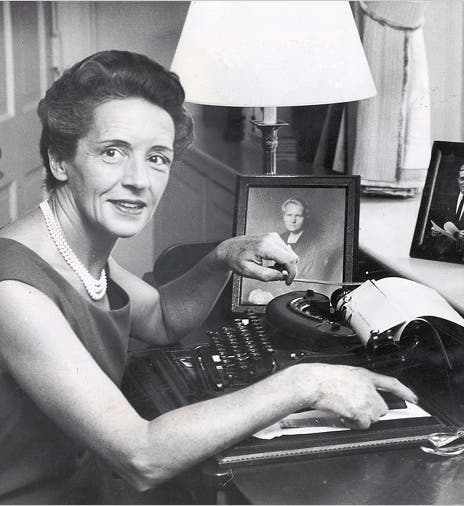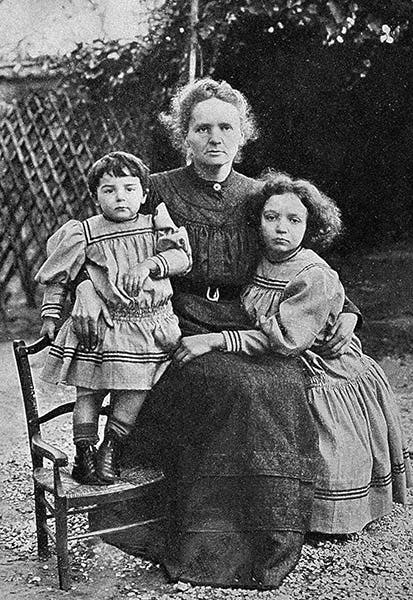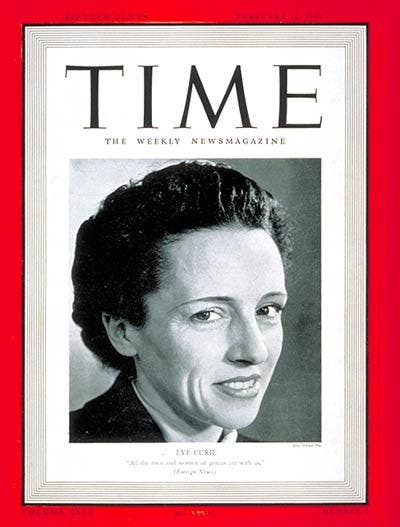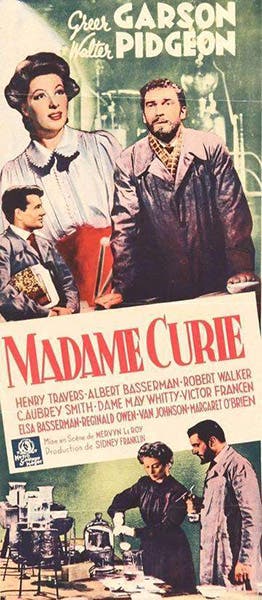Scientist of the Day - Eve Curie
Eve Curie, writer, biographer, and public spokesperson for the women of France, was born Dec. 6, 1904. Eve was the younger daughter of Marie and Pierre Curie, sister to Irène Joliot-Curie, and sister-in-law to Frédéric Joliot-Curie, all of whom had been awarded Nobel Prizes in physics or chemistry by 1935. Eve was not yet born when Marie and Pierre shared a Nobel prize for their early work in the new field of radioactivity in 1903, and she was only 16 months old when Pierre died after being struck by a carriage in the spring of 1906. Eve was 5 when Marie won her second Nobel prize, this time in chemistry, for the discovery of radium and polonium, and 6 when Marie had an affair with married physicist Paul Langevin that was the scandal of Paris in 1911. Eve was never interested in being a scientist, and she became a journalist and writer instead, penning pieces for a variety of Parisian publications. She accompanied her mother (as did Irène) when Marie made her first visit to the United States in 1921, seeking a gram of radium for her research at the Radium Institute, and she was impressed by the outpouring of American affection for Marie (her campaign was successful, as $100,000 was raised to purchase the vital gram of radium).
After Marie died of aplastic anemia in 1934 (Eve was the one who nursed Marie through her final illness), it was suggested to Eve that she write a biography of her mother. After initial reservations, she agreed to do so. As would most of us, she came to realize that she didn't really know her parents, and she had to do a considerable amount of research, including travelling to Poland to read letters sent home. Madame Curie was published in 1937, simultaneously in French, English, and Spanish (third image). It was a best-seller, for a biography, and was soon translated into many other languages. It is a beautifully written memoir, won numerous awards, and is still quite readable, but it is very much a loving daughter's story, and if you seek the sordid details of the Langevin affair, you will not find them. Indeed, you will not find the affair mentioned at all.
Eve's finest hour came, not with the biography, but with the war. When Paris was under attack by the Germans, she came to the United States in early 1940 to seek American support for France. Her appearances, of which there were many, stressed the role French women were playing in the economy of France when the men were called to battle, and she called on U.S. women to do the same. She was a very effective spokeswoman; she had always been elegant and glamorous, but now she showed a dignified eloquence that impressed every audience. She was invited to dine at the White House with FDR and Eleanor, and was such a hit that she stayed the night; a week later, she was featured on the cover of Time (fourth image)
After the War, Eve married Henry Labouisse, a senior diplomat at the United Nations, and in 1958, she became a U.S. citizen. Unlike her sister Irène, who died in 1956 at age 58, Eve lived to be 103 and died in 2007, showing the benefits of a life far away from radium.
Eve's Madame Curie was the basis for a film, Marie Curie, released in 1943 and starring Greer Garson as Marie and Walter Pidgeon as Pierre (fifth image). It is not easy to make laboratory work seem exciting on screen, but the movie did better than most cinematic scientific biographies. It is worth viewing, on those infrequent occasions when it is shown on Turner Classic Movies, usually during Greer Garson week.
Dr. William B. Ashworth, Jr., Consultant for the History of Science, Linda Hall Library and Associate Professor emeritus, Department of History, University of Missouri-Kansas City. Comments or corrections are welcome; please direct to ashworthw@umkc.edu.










